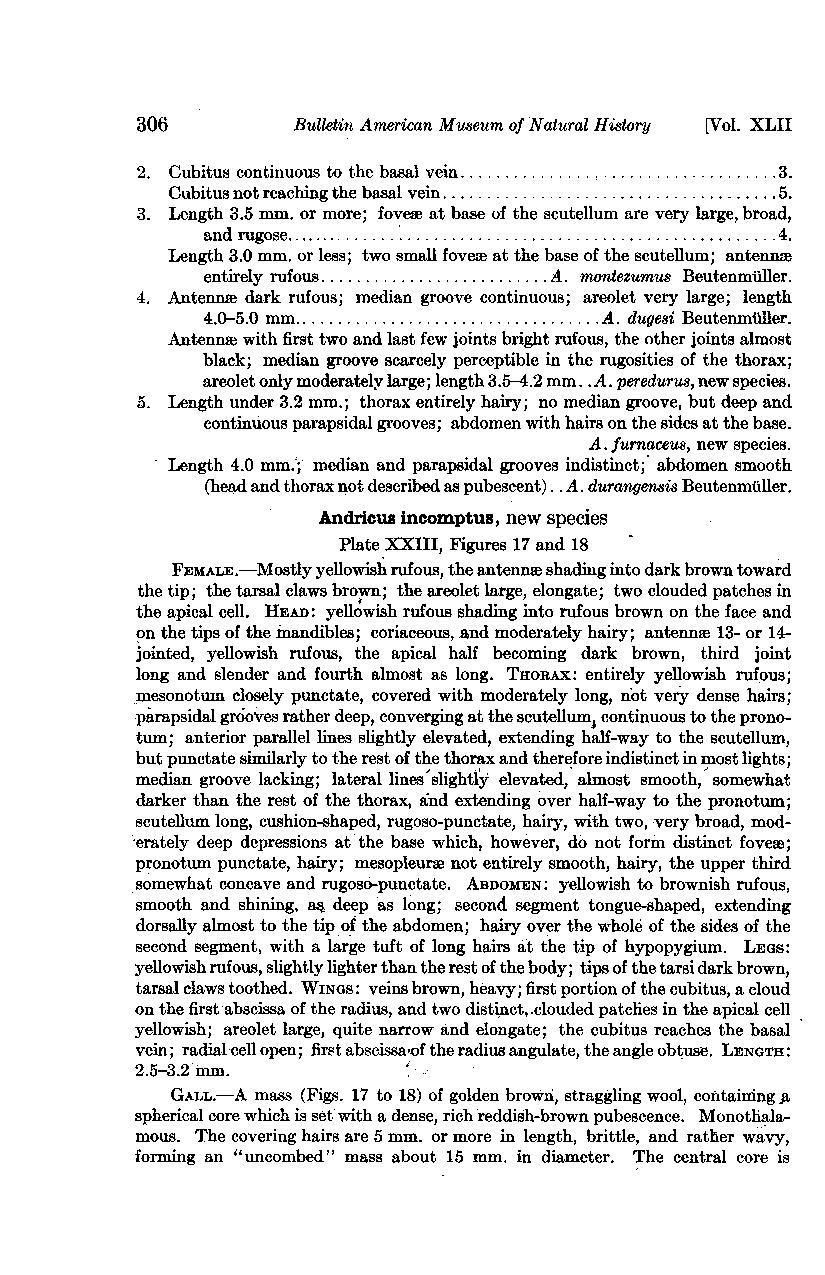This page has been validated.
306
Bulletin American Museum of Natural History
[Vol. XLII
| 2. | Cubitus continuous to the basal vein | 3. |
| Cubitus not reaching the basal vein | 5. | |
| 3. | Length 3.5 mm. or more; foveæ at base of the scutellum are very large, broad, and rugose | 4. |
| Length 3.0 mm. or less; two small foveæ at the base of the scutellum; antennae entirely rufous | A. montezumus Beutenmüller. | |
| 4. | Antenne dark rufous; median groove continuous; areolet very large; length 4.0–5.0 mm | A. dugesi Beutenmüller. |
| Antenne with first two and last few joints bright rufous, the other joints almost black; median groove scarcely perceptible in the rugosities of the thorax; areolet only moderately large; length 3.5–4.2 mm | A. peredurus, new species. | |
| 5. | Length under 3.2 mm.; thorax entirely hairy; no median groove, but deep and continuous parapsidal grooves; abdomen with hairs on the sides at the base. | A. furnaceus, new species. |
| Length 4.0 mm.; median and parapsidal grooves indistinct; abdomen smooth (head and thorax not described as pubescent) | A. durangensis Beutenmüller. |
Andricus incomptus, new species
Plate XXIII, Figures 17 and 18
Female.—Mostly yellowish rufous, the antennæ shading into dark brown toward the tip; the tarsal claws brown; the areolet large, elongate; two clouded patches in the apical cell. Head: yellowish rufous shading into rufous brown on the face and on the tips of the mandibles; coriaceous, and moderately hairy; antennæ 13- or 14-jointed, yellowish rufous, the apical half becoming dark brown, third joint long and slender and fourth almost as long. Thorax: entirely yellowish rufous; mesonotum closely punctate, covered with moderately long, not very dense hairs; parapsidal grooves rather deep, converging at the scutellum, continuous to the pronotum; anterior parallel lines slightly elevated, extending half-way to the scutellum, but punctate similarly to the rest of the thorax and therefore indistinct in most lights; median groove lacking; lateral lines slightly elevated, almost smooth, somewhat darker than the rest of the thorax, and extending over half-way to the pronotum; scutellum long, cushion-shaped, rugoso-punctate, hairy, with two, very broad, moderately deep depressions at the base which, however, do not form distinct fovea; pronotum punctate, hairy; mesopleuræ not entirely smooth, hairy, the upper third somewhat concave and rugoso-punctate. Abdomen: yellowish to brownish rufous, smooth and shining, as deep as long; second segment tongue-shaped, extending dorsally almost to the tip of the abdomen; hairy over the whole of the sides of the second segment, with a large tuft of long hairs at the tip of hypopygium. Legs: yellowish rufous, slightly lighter than the rest of the body; tips of the tarsi dark brown, tarsal claws toothed. Wings: veins brown, heavy; first portion of the cubitus, a cloud on the first-abscissa of the radius, and two distinct, clouded patches in the apical cell yellowish; areolet large, quite narrow and elongate; the cubitus reaches the basal vein; radial cell open; first abscissa of the radius angulate, the angle obtuse. Length: 2.5-3.2 mm.
Gall.—A mass (Figs. 17 to 18) of golden brown, straggling wool, containing a spherical core which is set with a dense, rich reddish-brown pubescence. Monothalamous. The covering hairs are 5 mm. or more in length, brittle, and rather wavy, forming an “uncombed” mass about 15 mm. in diameter. The central core is
